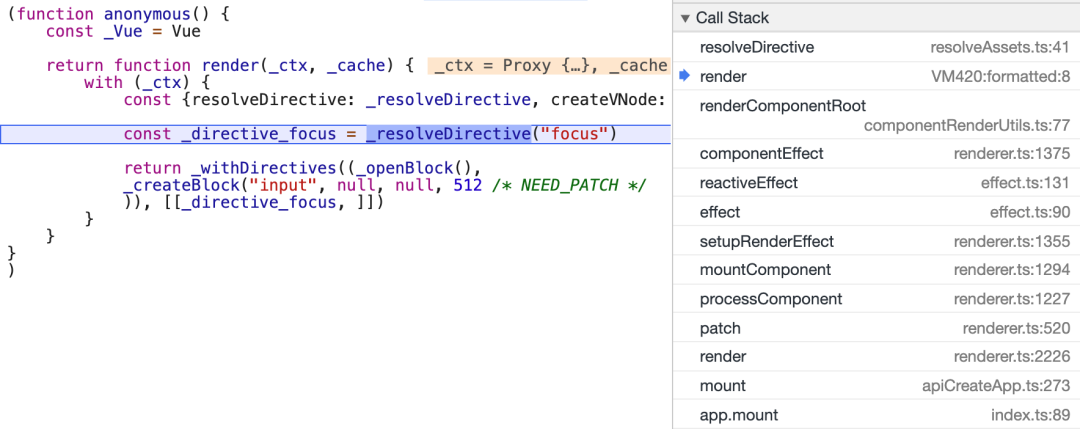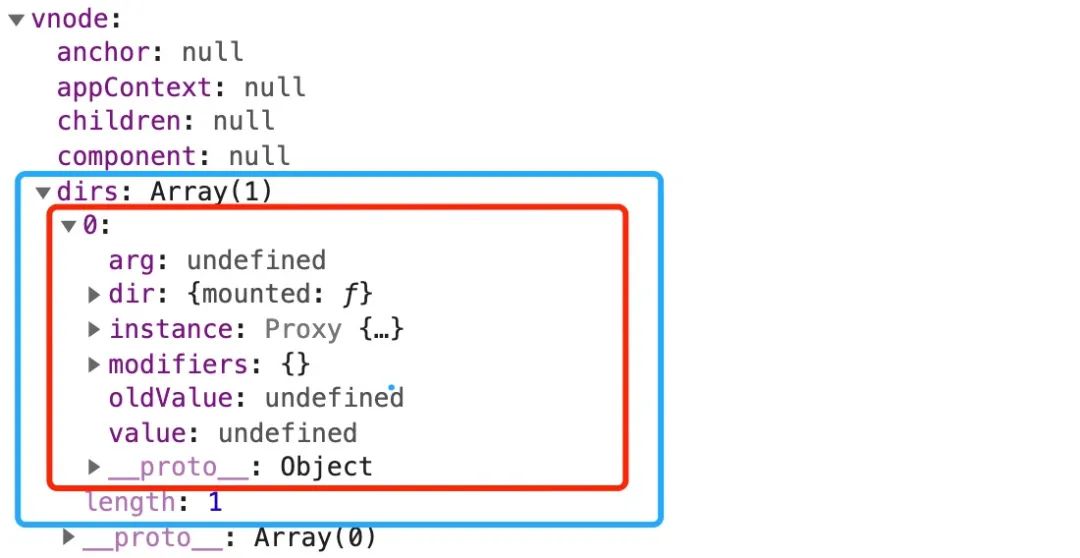在 Vue 的项目中,我们经常会遇到 v-if、v-show、v-for 或 v-model 这些内置指令,它们为我们提供了不同的功能。除了使用这些内置指令之外,Vue 也允许注册自定义指令。
接下来,将使用 Vue 3 官方文档 自定义指令 章节中使用的示例,来一步步揭开自定义指令背后的秘密。
提示:在阅读本文前,建议您先阅读 Vue 3 官方文档 自定义指令 章节的内容。
1、注册全局自定义指令
const app = Vue.createApp({})
// 注册一个全局自定义指令 v-focus
app.directive('focus', {
// 当被绑定的元素挂载到 DOM 中时被调用
mounted(el) {
// 聚焦元素
el.focus()
}
})2、使用全局自定义指令
<div id="app">
<input v-focus />
</div>3、完整的使用示例
<div id="app">
<input v-focus />
</div>
<script>
const { createApp } = Vue
const app = Vue.createApp({}) // ①
app.directive('focus', { // ②
// 当被绑定的元素挂载到 DOM 中时被调用
mounted(el) {
el.focus() // 聚焦元素
}
})
app.mount('#app') // ③
</script>当页面加载完成后,页面中的输入框元素将自动获得焦点。该示例的代码比较简单,主要包含 3 个步骤:创建 App 对象、注册全局自定义指令和应用挂载。其中创建 App 对象的细节,阿宝哥会在后续的文章中单独介绍,下面我们将重点分析其他 2 个步骤。首先我们先来分析注册全局自定义指令的过程。
在以上示例中,我们使用 app 对象的 directive 方法来注册全局自定义指令:
app.directive('focus', {
// 当被绑定的元素挂载到 DOM 中时被调用
mounted(el) {
el.focus() // 聚焦元素
}
})当然,除了注册全局自定义指令外,我们也可以注册局部指令,因为组件中也接受一个 directives 的选项:
directives: {
focus: {
mounted(el) {
el.focus()
}
}
}对于以上示例来说,我们使用的 app.directive 方法被定义在 runtime-core/src/apiCreateApp.ts 文件中:
// packages/runtime-core/src/apiCreateApp.ts
export function createAppAPI<HostElement>(
render: RootRenderFunction,
hydrate?: RootHydrateFunction
): CreateAppFunction<HostElement> {
return function createApp(rootComponent, rootProps = null) {
const context = createAppContext()
let isMounted = false
const app: App = (context.app = {
// 省略部分代码
_context: context,
// 用于注册或检索全局指令。
directive(name: string, directive?: Directive) {
if (__DEV__) {
validateDirectiveName(name)
}
if (!directive) {
return context.directives[name] as any
}
if (__DEV__ && context.directives[name]) {
warn(`Directive "${name}" has already been registered in target app.`)
}
context.directives[name] = directive
return app
},
return app
}
}通过观察以上代码,我们可以知道 directive 方法支持以下两个参数:
name 参数比较简单,所以我们重点分析 directive 参数,该参数的类型是 Directive 类型:
// packages/runtime-core/src/directives.ts
export type Directive<T = any, V = any> =
| ObjectDirective<T, V>
| FunctionDirective<T, V>由上可知 Directive 类型属于联合类型,所以我们需要继续分析 ObjectDirective 和 FunctionDirective 类型。这里我们先来看一下 ObjectDirective 类型的定义:
// packages/runtime-core/src/directives.ts
export interface ObjectDirective<T = any, V = any> {
created?: DirectiveHook<T, null, V>
beforeMount?: DirectiveHook<T, null, V>
mounted?: DirectiveHook<T, null, V>
beforeUpdate?: DirectiveHook<T, VNode<any, T>, V>
updated?: DirectiveHook<T, VNode<any, T>, V>
beforeUnmount?: DirectiveHook<T, null, V>
unmounted?: DirectiveHook<T, null, V>
getSSRProps?: SSRDirectiveHook
}该类型定义了对象类型的指令,对象上的每个属性表示指令生命周期上的钩子。而 FunctionDirective 类型则表示函数类型的指令:
// packages/runtime-core/src/directives.ts
export type FunctionDirective<T = any, V = any> = DirectiveHook<T, any, V>
export type DirectiveHook<T = any, Prev = VNode<any, T> | null, V = any> = (
el: T,
binding: DirectiveBinding<V>,
vnode: VNode<any, T>,
prevVNode: Prev
) => void 介绍完 Directive 类型,我们再回顾一下前面的示例,相信你就会清晰很多:
app.directive('focus', {
// 当被绑定的元素挂载到 DOM 中时触发
mounted(el) {
el.focus() // 聚焦元素
}
})对于以上示例,当我们调用 app.directive 方法注册自定义 focus 指令时,就会执行以下逻辑:
directive(name: string, directive?: Directive) {
if (__DEV__) { // 避免自定义指令名称,与已有的内置指令名称冲突
validateDirectiveName(name)
}
if (!directive) { // 获取name对应的指令对象
return context.directives[name] as any
}
if (__DEV__ && context.directives[name]) {
warn(`Directive "${name}" has already been registered in target app.`)
}
context.directives[name] = directive // 注册全局指令
return app
}当 focus 指令注册成功之后,该指令会被保存在 context 对象的 directives 属性中,具体如下图所示:

context 是表示应用的上下文对象,那么该对象是如何创建的呢?其实,该对象是通过 createAppContext 函数来创建的:
const context = createAppContext()而 createAppContext 函数被定义在 runtime-core/src/apiCreateApp.ts 文件中:
// packages/runtime-core/src/apiCreateApp.ts
export function createAppContext(): AppContext {
return {
app: null as any,
config: {
isNativeTag: NO,
performance: false,
globalProperties: {},
optionMergeStrategies: {},
isCustomElement: NO,
errorHandler: undefined,
warnHandler: undefined
},
mixins: [],
components: {},
directives: {},
provides: Object.create(null)
}
}看到这里,是不是觉得注册全局自定义指令的内部处理逻辑其实挺简单的。那么对于已注册的 focus 指令,何时会被调用呢?要回答这个问题,我们就需要分析另一个步骤 —— 应用挂载。
为了更加直观地了解应用挂载的过程,阿宝哥利用 Chrome 开发者工具,记录了应用挂载的主要过程:

resolveDirective。很明显,该函数用于解析指令,且该函数在 render 方法中会被调用。在源码中,我们找到了该函数的定义:
// packages/runtime-core/src/helpers/resolveAssets.ts
export function resolveDirective(name: string): Directive | undefined {
return resolveAsset(DIRECTIVES, name)
}在 resolveDirective 函数内部,会继续调用 resolveAsset 函数来执行具体的解析操作。在分析 resolveAsset 函数的具体实现之前,我们在 resolveDirective 函数内部加个断点,来一睹 render 方法的 “芳容”:

focus 指令相关的 _resolveDirective("focus") 函数调用。前面我们已经知道在 resolveDirective 函数内部会继续调用 resolveAsset 函数,该函数的具体实现如下:
// packages/runtime-core/src/helpers/resolveAssets.ts
function resolveAsset(
type: typeof COMPONENTS | typeof DIRECTIVES,
name: string,
warnMissing = true
) {
const instance = currentRenderingInstance || currentInstance
if (instance) {
const Component = instance.type
// 省略解析组件的处理逻辑
const res =
// 局部注册
resolve(instance[type] || (Component as ComponentOptions)[type], name) ||
// 全局注册
resolve(instance.appContext[type], name)
return res
} else if (__DEV__) {
warn(
`resolve${capitalize(type.slice(0, -1))} ` +
`can only be used in render() or setup().`
)
}
}因为注册 focus 指令时,使用的是全局注册的方式,所以解析的过程会执行 resolve(instance.appContext[type], name) 该语句,其中 resolve 方法的定义如下:
function resolve(registry: Record<string, any> | undefined, name: string) {
return (
registry &&
(registry[name] ||
registry[camelize(name)] ||
registry[capitalize(camelize(name))])
)
}分析完以上的处理流程,我们可以知道在解析全局注册的指令时,会通过 resolve 函数从应用的上下文对象中获取已注册的指令对象。在获取到 _directive_focus 指令对象后,render 方法内部会继续调用 _withDirectives 函数,用于把指令添加到 VNode 对象上,该函数被定义在 runtime-core/src/directives.ts 文件中:
// packages/runtime-core/src/directives.ts
export function withDirectives<T extends VNode>(
vnode: T,
directives: DirectiveArguments
): T {
const internalInstance = currentRenderingInstance // 获取当前渲染的实例
const instance = internalInstance.proxy
const bindings: DirectiveBinding[] = vnode.dirs || (vnode.dirs = [])
for (let i = 0; i < directives.length; i++) {
let [dir, value, arg, modifiers = EMPTY_OBJ] = directives[i]
// 在 mounted 和 updated 时,触发相同行为,而不关系其他的钩子函数
if (isFunction(dir)) { // 处理函数类型指令
dir = {
mounted: dir,
updated: dir
} as ObjectDirective
}
bindings.push({
dir,
instance,
value,
oldValue: void 0,
arg,
modifiers
})
}
return vnode
}因为一个节点上可能会应用多个指令,所以 withDirectives 函数在 VNode 对象上定义了一个 dirs 属性且该属性值为数组。对于前面的示例来说,在调用 withDirectives 函数之后,VNode 对象上就会新增一个 dirs 属性,具体如下图所示:

render 方法中,我们会通过 withDirectives 函数把指令注册对应的 VNode 对象上。那么 focus 指令上定义的钩子什么时候会被调用呢?在继续分析之前,我们先来介绍一下指令对象所支持的钩子函数。
一个指令定义对象可以提供如下几个钩子函数 (均为可选):
created:在绑定元素的属性或事件监听器被应用之前调用。beforeMount:当指令第一次绑定到元素并且在挂载父组件之前调用。mounted:在绑定元素的父组件被挂载后调用。beforeUpdate:在更新包含组件的 VNode 之前调用。updated:在包含组件的 VNode 及其子组件的 VNode 更新后调用。beforeUnmount:在卸载绑定元素的父组件之前调用。unmounted:当指令与元素解除绑定且父组件已卸载时,只调用一次。介绍完这些钩子函数之后,我们再来回顾一下前面介绍的 ObjectDirective 类型:
// packages/runtime-core/src/directives.ts
export interface ObjectDirective<T = any, V = any> {
created?: DirectiveHook<T, null, V>
beforeMount?: DirectiveHook<T, null, V>
mounted?: DirectiveHook<T, null, V>
beforeUpdate?: DirectiveHook<T, VNode<any, T>, V>
updated?: DirectiveHook<T, VNode<any, T>, V>
beforeUnmount?: DirectiveHook<T, null, V>
unmounted?: DirectiveHook<T, null, V>
getSSRProps?: SSRDirectiveHook
}好的,接下来我们来分析一下 focus 指令上定义的钩子什么时候被调用。同样,阿宝哥在 focus 指令的 mounted 方法中加个断点:

invokeDirectiveHook 函数,很明显该函数的作用就是调用指令上已注册的钩子。出于篇幅考虑,具体的细节阿宝哥就不继续介绍了,感兴趣的小伙伴可以自行断点调试一下。
在介绍注册全局自定义指令的过程中,我们看到了一个 validateDirectiveName 函数,该函数用于验证自定义指令的名称,从而避免自定义指令名称,与已有的内置指令名称冲突。
// packages/runtime-core/src/directives.ts
export function validateDirectiveName(name: string) {
if (isBuiltInDirective(name)) {
warn('Do not use built-in directive ids as custom directive id: ' + name)
}
}在 validateDirectiveName 函数内部,会通过 isBuiltInDirective(name) 语句来判断是否为内置指令:
const isBuiltInDirective = /*#__PURE__*/ makeMap(
'bind,cloak,else-if,else,for,html,if,model,on,once,pre,show,slot,text'
)以上代码中的 makeMap 函数,用于生成一个 map 对象(Object.create(null))并返回一个函数,用于检测某个 key 是否存在 map 对象中。另外,通过以上代码,我们就可以很清楚地了解 Vue 3 中为我们提供了哪些内置指令。
在 Vue 3 中指令分为 ObjectDirective 和 FunctionDirective 两种类型:
// packages/runtime-core/src/directives.ts
export type Directive<T = any, V = any> =
| ObjectDirective<T, V>
| FunctionDirective<T, V>export interface ObjectDirective<T = any, V = any> {
created?: DirectiveHook<T, null, V>
beforeMount?: DirectiveHook<T, null, V>
mounted?: DirectiveHook<T, null, V>
beforeUpdate?: DirectiveHook<T, VNode<any, T>, V>
updated?: DirectiveHook<T, VNode<any, T>, V>
beforeUnmount?: DirectiveHook<T, null, V>
unmounted?: DirectiveHook<T, null, V>
getSSRProps?: SSRDirectiveHook
}export type FunctionDirective<T = any, V = any> = DirectiveHook<T, any, V>
export type DirectiveHook<T = any, Prev = VNode<any, T> | null, V = any> = (
el: T,
binding: DirectiveBinding<V>,
vnode: VNode<any, T>,
prevVNode: Prev
) => void如果你想在 mounted 和 updated 时触发相同行为,而不关心其他的钩子函数。那么你可以通过将回调函数传递给指令来实现:
app.directive('pin', (el, binding) => {
el.style.position = 'fixed'
const s = binding.arg || 'top'
el.style[s] = binding.value + 'px'
})app.directive('focus', {
// 当被绑定的元素挂载到 DOM 中时被调用
mounted(el) {
el.focus() // 聚焦元素
}
});const Component = defineComponent({
directives: {
focus: {
mounted(el) {
el.focus()
}
}
},
render() {
const { directives } = this.$options;
return [withDirectives(h('input'), [[directives.focus, ]])]
}
});// packages/runtime-core/src/helpers/resolveAssets.ts
function resolveAsset(
type: typeof COMPONENTS | typeof DIRECTIVES,
name: string,
warnMissing = true
) {
const instance = currentRenderingInstance || currentInstance
if (instance) {
const Component = instance.type
// 省略解析组件的处理逻辑
const res =
// 局部注册
resolve(instance[type] || (Component as ComponentOptions)[type], name) ||
// 全局注册
resolve(instance.appContext[type], name)
return res
}
}要了解内置指令和自定义指令生成的渲染函数的区别,阿宝哥以 v-if 、v-show 内置指令和 v-focus 自定义指令为例,然后使用 Vue 3 Template Explorer 这个在线工具来编译生成渲染函数:
<input v-if="isShow" />
const _Vue = Vue
return function render(_ctx, _cache, $props, $setup, $data, $options) {
with (_ctx) {
const { createVNode: _createVNode, openBlock: _openBlock,
createBlock: _createBlock, createCommentVNode: _createCommentVNode } = _Vue
return isShow
? (_openBlock(), _createBlock("input", { key: 0 }))
: _createCommentVNode("v-if", true)
}
}对于 v-if 指令来说,在编译后会通过 ?: 三目运算符来实现动态创建节点的功能。
<input v-show="isShow" />
const _Vue = Vue
return function render(_ctx, _cache, $props, $setup, $data, $options) {
with (_ctx) {
const { vShow: _vShow, createVNode: _createVNode, withDirectives: _withDirectives,
openBlock: _openBlock, createBlock: _createBlock } = _Vue
return _withDirectives((_openBlock(), _createBlock("input", null, null, 512 /* NEED_PATCH */)), [
[_vShow, isShow]
])
}
}以上示例中的 vShow 指令被定义在 packages/runtime-dom/src/directives/vShow.ts 文件中,该指令属于 ObjectDirective 类型的指令,该指令内部定义了 beforeMount、mounted、updated 和 beforeUnmount 四个钩子。
<input v-focus />
const _Vue = Vue
return function render(_ctx, _cache, $props, $setup, $data, $options) {
with (_ctx) {
const { resolveDirective: _resolveDirective, createVNode: _createVNode,
withDirectives: _withDirectives, openBlock: _openBlock, createBlock: _createBlock } = _Vue
const _directive_focus = _resolveDirective("focus")
return _withDirectives((_openBlock(), _createBlock("input", null, null, 512 /* NEED_PATCH */)), [
[_directive_focus]
])
}
}通过对比 v-focus 与 v-show 指令生成的渲染函数,我们可知 v-focus 自定义指令与 v-show 内置指令都会通过 withDirectives 函数,把指令注册到 VNode 对象上。而自定义指令相比内置指令来说,会多一个指令解析的过程。
此外,如果在 input 元素上,同时应用了 v-show 和 v-focus 指令,则在调用 _withDirectives 函数时,将使用二维数组:
<input v-show="isShow" v-focus />
const _Vue = Vue
return function render(_ctx, _cache, $props, $setup, $data, $options) {
with (_ctx) {
const { vShow: _vShow, resolveDirective: _resolveDirective, createVNode: _createVNode,
withDirectives: _withDirectives, openBlock: _openBlock, createBlock: _createBlock } = _Vue
const _directive_focus = _resolveDirective("focus")
return _withDirectives((_openBlock(), _createBlock("input", null, null, 512 /* NEED_PATCH */)), [
[_vShow, isShow],
[_directive_focus]
])
}
}除了在模板中应用指令之外,利用前面介绍的 withDirectives 函数,我们可以很方便地在渲染函数中应用指定的指令:
<div id="app"></div>
<script>
const { createApp, h, vShow, defineComponent, withDirectives } = Vue
const Component = defineComponent({
data() {
return { value: true }
},
render() {
return [withDirectives(h('div', '我是阿宝哥'), [[vShow, this.value]])]
}
});
const app = Vue.createApp(Component)
app.mount('#app')
</script>本文主要介绍了在 Vue 3 中如何自定义指令、如何注册全局和局部指令。为了让大家能够更深入地掌握自定义指令的相关知识,从源码的角度分析了指令的注册和应用过程。
本文由哈喽比特于4年以前收录,如有侵权请联系我们。
文章来源:https://mp.weixin.qq.com/s/Atbu3NMf3Od7qTqdUz8ftw
京东创始人刘强东和其妻子章泽天最近成为了互联网舆论关注的焦点。有关他们“移民美国”和在美国购买豪宅的传言在互联网上广泛传播。然而,京东官方通过微博发言人发布的消息澄清了这些传言,称这些言论纯属虚假信息和蓄意捏造。
日前,据博主“@超能数码君老周”爆料,国内三大运营商中国移动、中国电信和中国联通预计将集体采购百万台规模的华为Mate60系列手机。
据报道,荷兰半导体设备公司ASML正看到美国对华遏制政策的负面影响。阿斯麦(ASML)CEO彼得·温宁克在一档电视节目中分享了他对中国大陆问题以及该公司面临的出口管制和保护主义的看法。彼得曾在多个场合表达了他对出口管制以及中荷经济关系的担忧。
今年早些时候,抖音悄然上线了一款名为“青桃”的 App,Slogan 为“看见你的热爱”,根据应用介绍可知,“青桃”是一个属于年轻人的兴趣知识视频平台,由抖音官方出品的中长视频关联版本,整体风格有些类似B站。
日前,威马汽车首席数据官梅松林转发了一份“世界各国地区拥车率排行榜”,同时,他发文表示:中国汽车普及率低于非洲国家尼日利亚,每百户家庭仅17户有车。意大利世界排名第一,每十户中九户有车。
近日,一项新的研究发现,维生素 C 和 E 等抗氧化剂会激活一种机制,刺激癌症肿瘤中新血管的生长,帮助它们生长和扩散。
据媒体援引消息人士报道,苹果公司正在测试使用3D打印技术来生产其智能手表的钢质底盘。消息传出后,3D系统一度大涨超10%,不过截至周三收盘,该股涨幅回落至2%以内。
9月2日,坐拥千万粉丝的网红主播“秀才”账号被封禁,在社交媒体平台上引发热议。平台相关负责人表示,“秀才”账号违反平台相关规定,已封禁。据知情人士透露,秀才近期被举报存在违法行为,这可能是他被封禁的部分原因。据悉,“秀才”年龄39岁,是安徽省亳州市蒙城县人,抖音网红,粉丝数量超1200万。他曾被称为“中老年...
9月3日消息,亚马逊的一些股东,包括持有该公司股票的一家养老基金,日前对亚马逊、其创始人贝索斯和其董事会提起诉讼,指控他们在为 Project Kuiper 卫星星座项目购买发射服务时“违反了信义义务”。
据消息,为推广自家应用,苹果现推出了一个名为“Apps by Apple”的网站,展示了苹果为旗下产品(如 iPhone、iPad、Apple Watch、Mac 和 Apple TV)开发的各种应用程序。
特斯拉本周在美国大幅下调Model S和X售价,引发了该公司一些最坚定支持者的不满。知名特斯拉多头、未来基金(Future Fund)管理合伙人加里·布莱克发帖称,降价是一种“短期麻醉剂”,会让潜在客户等待进一步降价。
据外媒9月2日报道,荷兰半导体设备制造商阿斯麦称,尽管荷兰政府颁布的半导体设备出口管制新规9月正式生效,但该公司已获得在2023年底以前向中国运送受限制芯片制造机器的许可。
近日,根据美国证券交易委员会的文件显示,苹果卫星服务提供商 Globalstar 近期向马斯克旗下的 SpaceX 支付 6400 万美元(约 4.65 亿元人民币)。用于在 2023-2025 年期间,发射卫星,进一步扩展苹果 iPhone 系列的 SOS 卫星服务。
据报道,马斯克旗下社交平台𝕏(推特)日前调整了隐私政策,允许 𝕏 使用用户发布的信息来训练其人工智能(AI)模型。新的隐私政策将于 9 月 29 日生效。新政策规定,𝕏可能会使用所收集到的平台信息和公开可用的信息,来帮助训练 𝕏 的机器学习或人工智能模型。
9月2日,荣耀CEO赵明在采访中谈及华为手机回归时表示,替老同事们高兴,觉得手机行业,由于华为的回归,让竞争充满了更多的可能性和更多的魅力,对行业来说也是件好事。
《自然》30日发表的一篇论文报道了一个名为Swift的人工智能(AI)系统,该系统驾驶无人机的能力可在真实世界中一对一冠军赛里战胜人类对手。
近日,非营利组织纽约真菌学会(NYMS)发出警告,表示亚马逊为代表的电商平台上,充斥着各种AI生成的蘑菇觅食科普书籍,其中存在诸多错误。
社交媒体平台𝕏(原推特)新隐私政策提到:“在您同意的情况下,我们可能出于安全、安保和身份识别目的收集和使用您的生物识别信息。”
2023年德国柏林消费电子展上,各大企业都带来了最新的理念和产品,而高端化、本土化的中国产品正在不断吸引欧洲等国际市场的目光。
罗永浩日前在直播中吐槽苹果即将推出的 iPhone 新品,具体内容为:“以我对我‘子公司’的了解,我认为 iPhone 15 跟 iPhone 14 不会有什么区别的,除了序(列)号变了,这个‘不要脸’的东西,这个‘臭厨子’。









